A novel cryptosystem using dynamics perturbation of logistic map
Recently, the chaotic cryptosystem has been
studied extensively [1]. The chaotic cryptography
employs chaotic dynamics generated by chao systems
to have the complexity for encryption; this is the
alternative approach to encrypt data, beside the
conventional approach of using numerical complexity
[2]. The main advantages of using chaos over the
conventional approach is the simpleness in design
and the elastic keyspace. However, the disadvantage
so far for chaotic crytosystem is the lack of
provability [3]. Extensive study has been pursuited to
make chaotic cyrpstosystem reliable and applicable.
There are few main ways in employing chaotic
systems for cryptography. Those are that (i) chaotic
state values are used as a random sequence for
encryption [4]; (ii) chaotic dynamics involves in
encryption and decryption by means of
perturbing/modulating on the initial vector (IV)
and/or on the control parameters [5]. The perturbation
is known as changing the value of state variable or of
control parameter during iterations. The proposed
cryptosystem in this paper is categorized into the
second way.
More recently, the statistical properties of bits in
bit layers of image have been analyzed [6]. It shows
that the statistics of bits in different bit layers of
image should be balanced, and the method of bit
balancing was proposed [7]. In that work, the
statistical properties of ciphertext produced by a
cryptosystem with the inclusion of bit balancing is
improved significantly.
* Corresponding author: Tel.: (+84) 988.802.694
Email: thang.hoangmanh@hust.edu.vn
In this work, a novel cryptosystem is proposed
with the use of Logistic map. The structure of the
cryptosystem is the Unified model [2], with
permutation and diffusion. The Logistic map is
employed for both permutation and diffusion. All the
chaotic value and the control parameter of Logistic
map are represented in the format of fixed point. The
perturbation is made in bit level to the control
parameter. In addition, the bit distribution balancing
is proposed to improve the statistical properties in the
ciphertext. The simulation result shows the
effectiveness of the proposed system and the
simulation results are compared with those in other
works published recently.
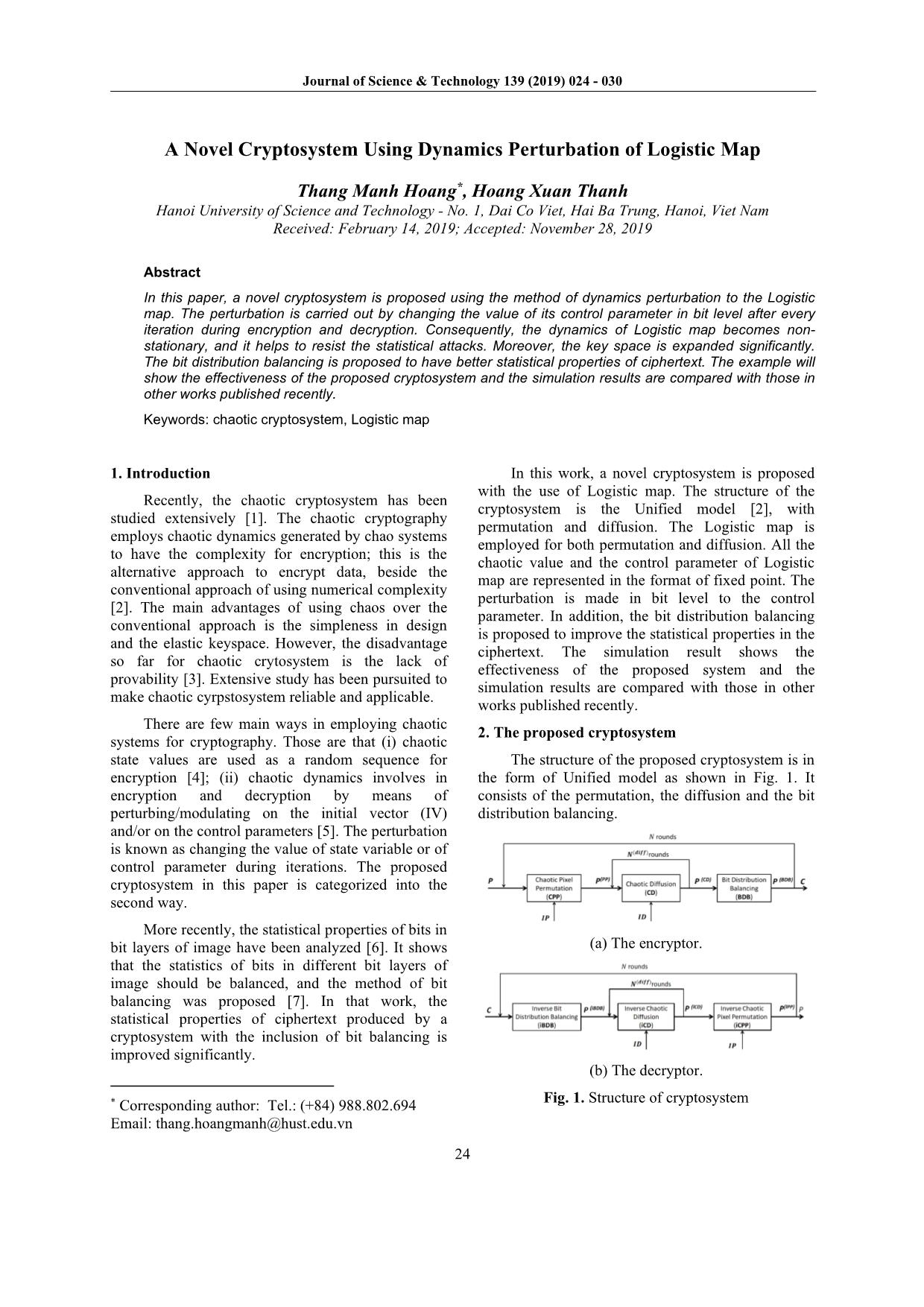
Trang 1
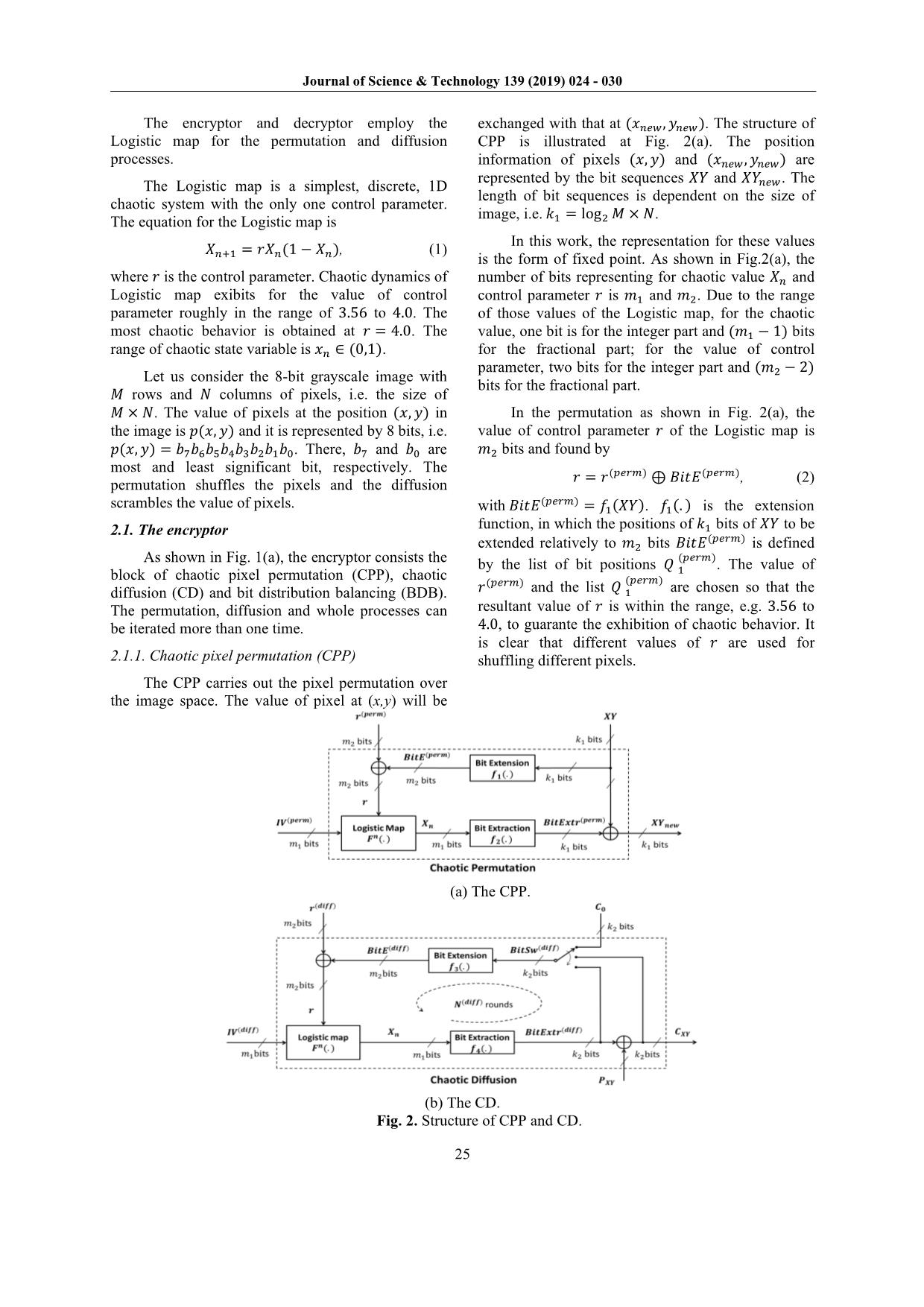
Trang 2
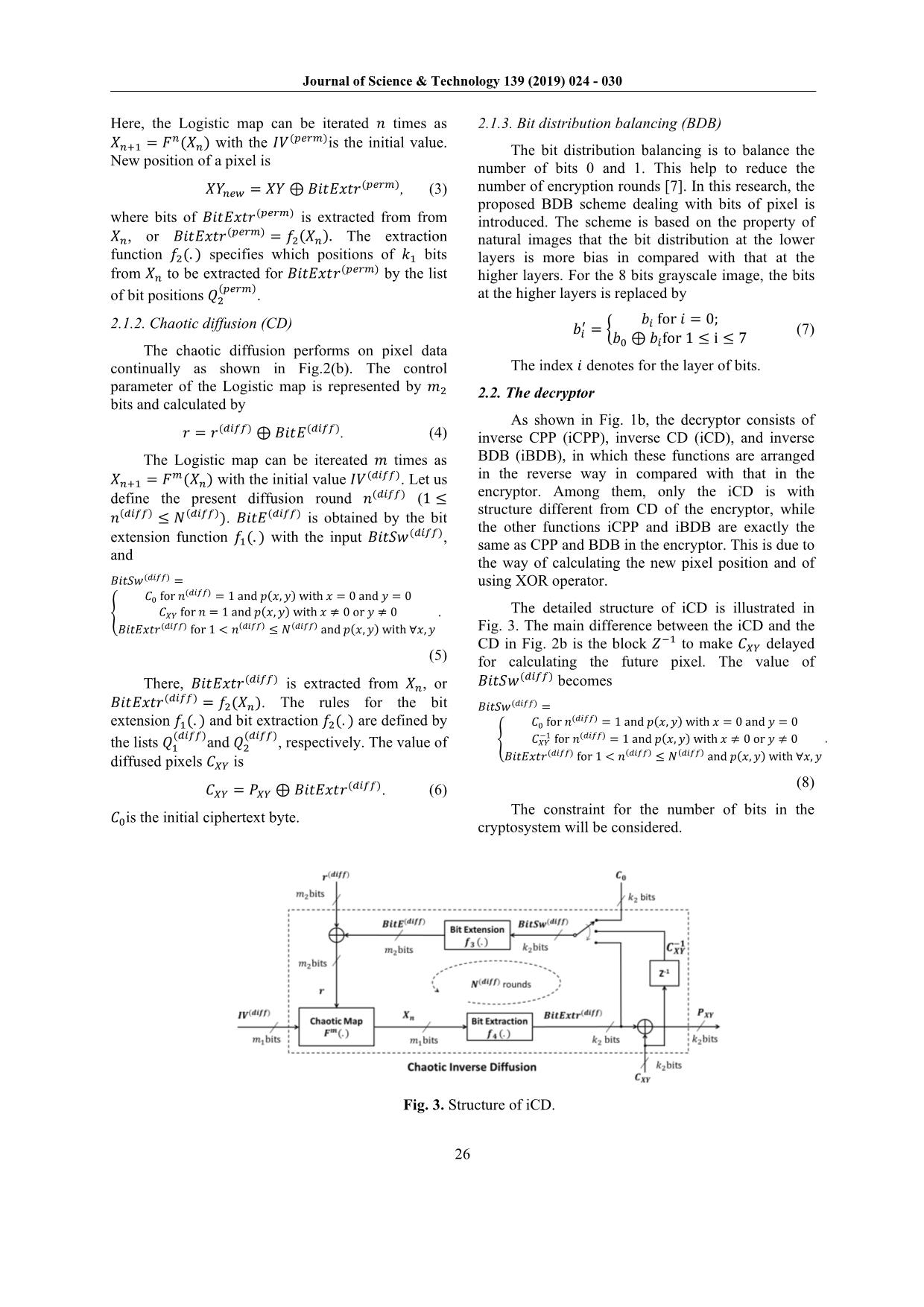
Trang 3
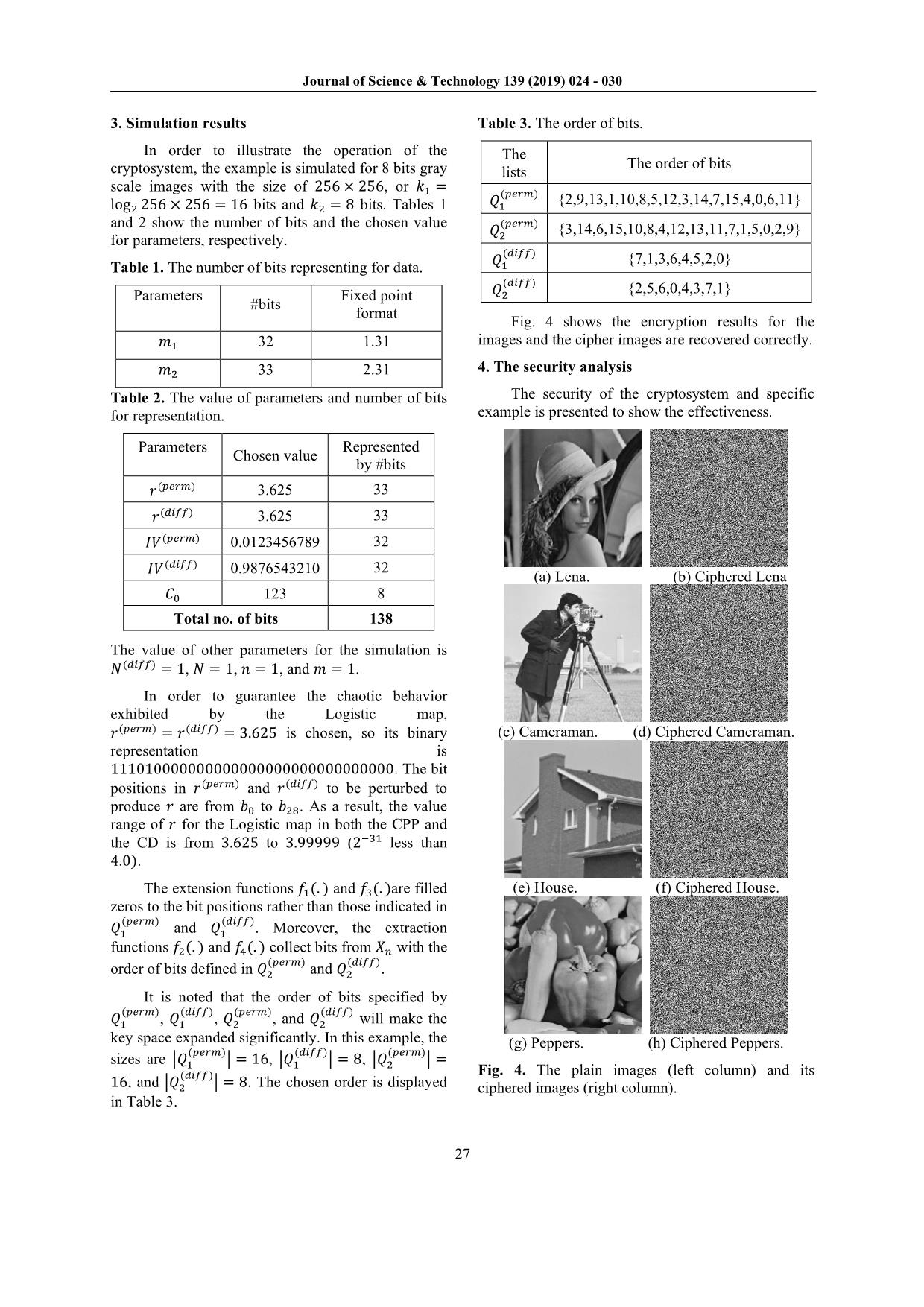
Trang 4
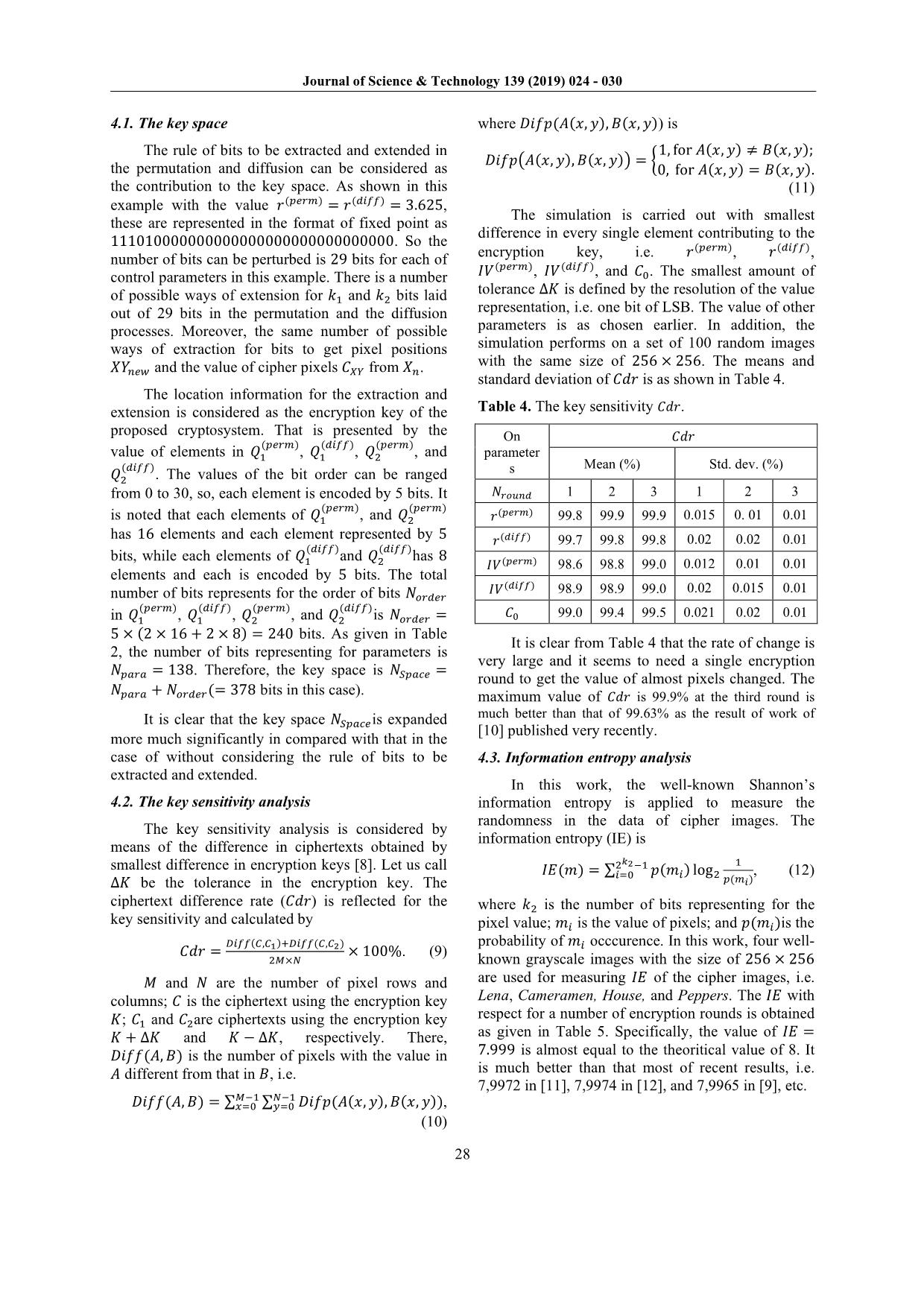
Trang 5
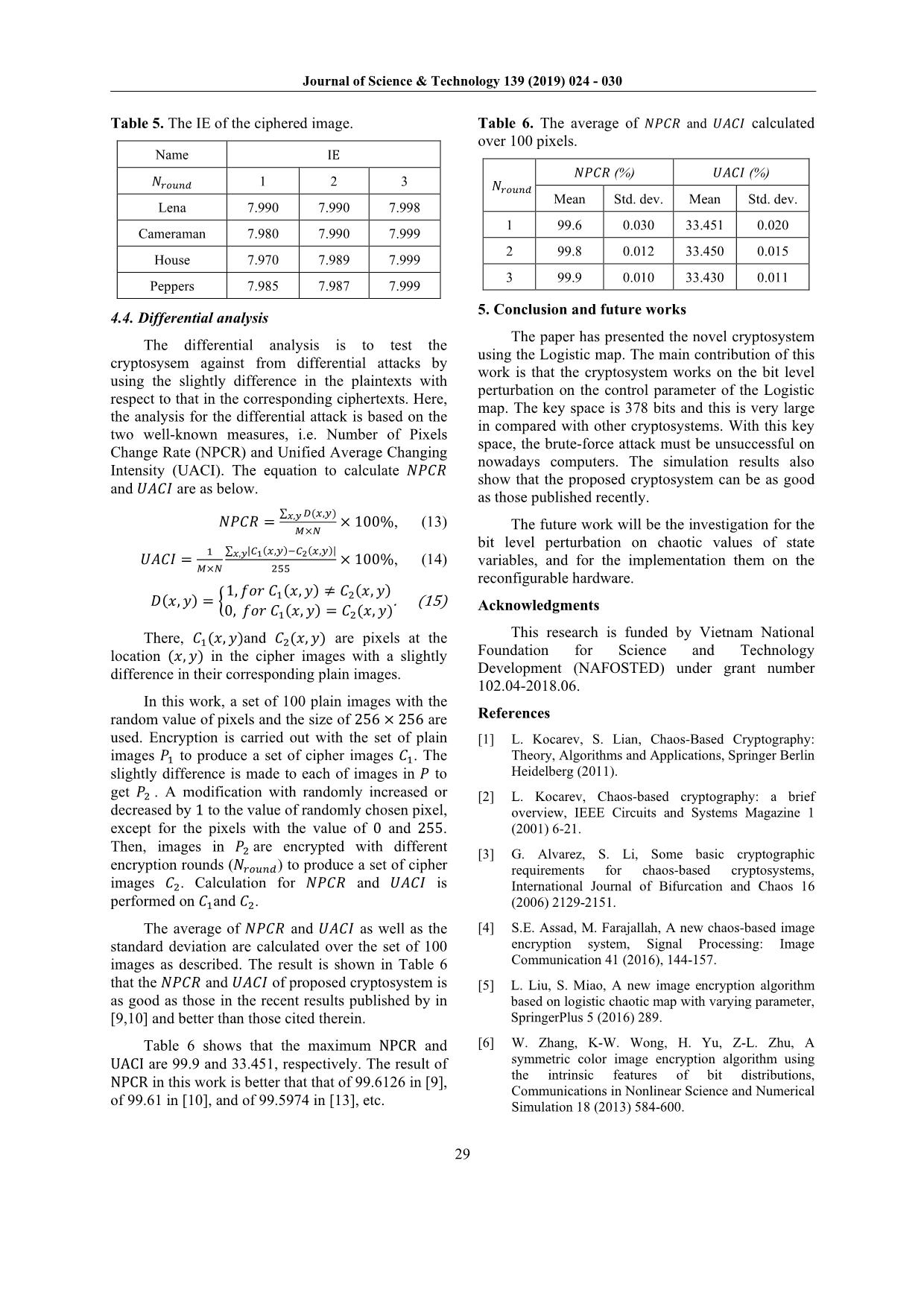
Trang 6
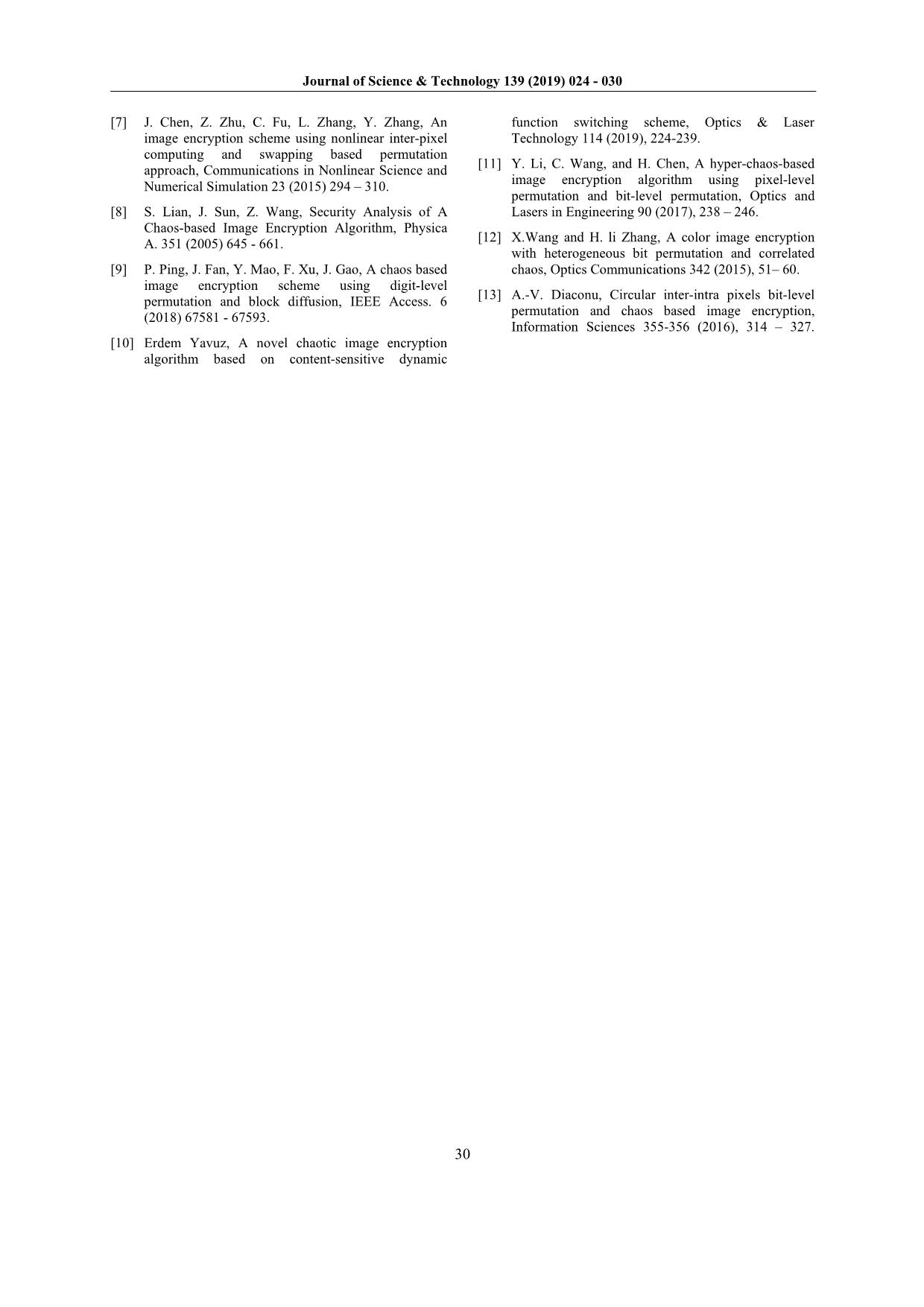
Trang 7
Tóm tắt nội dung tài liệu: A novel cryptosystem using dynamics perturbation of logistic map
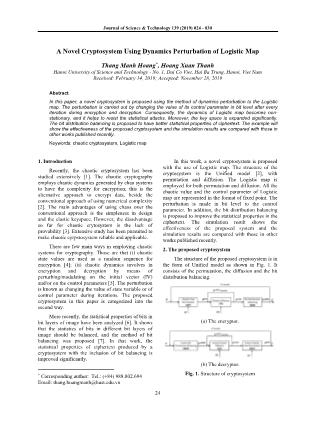
�−1 to make 𝐶𝐶𝑋𝑋𝑋𝑋 delayed
for calculating the future pixel. The value of
𝐵𝐵𝐵𝐵𝐵𝐵𝐵𝐵𝐵𝐵(𝑑𝑑𝑑𝑑𝑑𝑑𝑑𝑑) becomes
𝐵𝐵𝐵𝐵𝐵𝐵𝐵𝐵𝐵𝐵(𝑑𝑑𝑑𝑑𝑑𝑑𝑑𝑑) = � 𝐶𝐶0 for 𝑛𝑛(𝑑𝑑𝑑𝑑𝑑𝑑𝑑𝑑) = 1 and 𝑝𝑝(𝑥𝑥, 𝑦𝑦) with 𝑥𝑥 = 0 and 𝑦𝑦 = 0𝐶𝐶𝑋𝑋𝑋𝑋−1 for 𝑛𝑛(𝑑𝑑𝑑𝑑𝑑𝑑𝑑𝑑) = 1 and 𝑝𝑝(𝑥𝑥, 𝑦𝑦) with 𝑥𝑥 ≠ 0 or 𝑦𝑦 ≠ 0
𝐵𝐵𝐵𝐵𝐵𝐵𝐸𝐸𝑥𝑥𝐵𝐵𝑟𝑟(𝑑𝑑𝑑𝑑𝑑𝑑𝑑𝑑) for 1 < 𝑛𝑛(𝑑𝑑𝑑𝑑𝑑𝑑𝑑𝑑) ≤ 𝑁𝑁(𝑑𝑑𝑑𝑑𝑑𝑑𝑑𝑑) and 𝑝𝑝(𝑥𝑥, 𝑦𝑦) with ∀𝑥𝑥,𝑦𝑦 .
(8)
The constraint for the number of bits in the
cryptosystem will be considered.
Fig. 3. Structure of iCD.
Journal of Science & Technology 139 (2019) 024 - 030
27
3. Simulation results
In order to illustrate the operation of the
cryptosystem, the example is simulated for 8 bits gray
scale images with the size of 256 × 256, or 𝑘𝑘1 =log2 256 × 256 = 16 bits and 𝑘𝑘2 = 8 bits. Tables 1
and 2 show the number of bits and the chosen value
for parameters, respectively.
Table 1. The number of bits representing for data.
Parameters #bits Fixed point format
𝑚𝑚1 32 1.31
𝑚𝑚2 33 2.31
Table 2. The value of parameters and number of bits
for representation.
Parameters Chosen value Represented by #bits
𝑟𝑟(𝑝𝑝𝑛𝑛𝑝𝑝𝑝𝑝) 3.625 33
𝑟𝑟(𝑑𝑑𝑑𝑑𝑑𝑑𝑑𝑑) 3.625 33
𝐼𝐼𝑉𝑉(𝑝𝑝𝑛𝑛𝑝𝑝𝑝𝑝) 0.0123456789 32
𝐼𝐼𝑉𝑉(𝑑𝑑𝑑𝑑𝑑𝑑𝑑𝑑) 0.9876543210 32
𝐶𝐶0 123 8
Total no. of bits 138
The value of other parameters for the simulation is
𝑁𝑁(𝑑𝑑𝑑𝑑𝑑𝑑𝑑𝑑) = 1, 𝑁𝑁 = 1, 𝑛𝑛 = 1, and 𝑚𝑚 = 1.
In order to guarantee the chaotic behavior
exhibited by the Logistic map,
𝑟𝑟(𝑝𝑝𝑛𝑛𝑝𝑝𝑝𝑝) = 𝑟𝑟(𝑑𝑑𝑑𝑑𝑑𝑑𝑑𝑑) = 3.625 is chosen, so its binary
representation is 111010000000000000000000000000000. The bit
positions in 𝑟𝑟(𝑝𝑝𝑛𝑛𝑝𝑝𝑝𝑝) and 𝑟𝑟(𝑑𝑑𝑑𝑑𝑑𝑑𝑑𝑑) to be perturbed to
produce 𝑟𝑟 are from 𝑏𝑏0 to 𝑏𝑏28. As a result, the value
range of 𝑟𝑟 for the Logistic map in both the CPP and
the CD is from 3.625 to 3.99999 (2−31 less than 4.0).
The extension functions 𝑓𝑓1(. ) and 𝑓𝑓3(. )are filled
zeros to the bit positions rather than those indicated in
𝑄𝑄1
(𝑝𝑝𝑛𝑛𝑝𝑝𝑝𝑝) and 𝑄𝑄1(𝑑𝑑𝑑𝑑𝑑𝑑𝑑𝑑). Moreover, the extraction
functions 𝑓𝑓2(. ) and 𝑓𝑓4(. ) collect bits from 𝑋𝑋𝑛𝑛 with the
order of bits defined in 𝑄𝑄2
(𝑝𝑝𝑛𝑛𝑝𝑝𝑝𝑝) and 𝑄𝑄2(𝑑𝑑𝑑𝑑𝑑𝑑𝑑𝑑).
It is noted that the order of bits specified by
𝑄𝑄1
(𝑝𝑝𝑛𝑛𝑝𝑝𝑝𝑝), 𝑄𝑄1(𝑑𝑑𝑑𝑑𝑑𝑑𝑑𝑑), 𝑄𝑄2(𝑝𝑝𝑛𝑛𝑝𝑝𝑝𝑝), and 𝑄𝑄2(𝑑𝑑𝑑𝑑𝑑𝑑𝑑𝑑) will make the
key space expanded significantly. In this example, the
sizes are �𝑄𝑄1
(𝑝𝑝𝑛𝑛𝑝𝑝𝑝𝑝)� = 16, �𝑄𝑄1(𝑑𝑑𝑑𝑑𝑑𝑑𝑑𝑑)� = 8, �𝑄𝑄2(𝑝𝑝𝑛𝑛𝑝𝑝𝑝𝑝)� =16, and �𝑄𝑄2(𝑑𝑑𝑑𝑑𝑑𝑑𝑑𝑑)� = 8. The chosen order is displayed
in Table 3.
Table 3. The order of bits.
The
lists The order of bits
𝑄𝑄1
(𝑝𝑝𝑛𝑛𝑝𝑝𝑝𝑝) {2,9,13,1,10,8,5,12,3,14,7,15,4,0,6,11}
𝑄𝑄2
(𝑝𝑝𝑛𝑛𝑝𝑝𝑝𝑝) {3,14,6,15,10,8,4,12,13,11,7,1,5,0,2,9}
𝑄𝑄1
(𝑑𝑑𝑑𝑑𝑑𝑑𝑑𝑑) {7,1,3,6,4,5,2,0}
𝑄𝑄2
(𝑑𝑑𝑑𝑑𝑑𝑑𝑑𝑑) {2,5,6,0,4,3,7,1}
Fig. 4 shows the encryption results for the
images and the cipher images are recovered correctly.
4. The security analysis
The security of the cryptosystem and specific
example is presented to show the effectiveness.
(a) Lena. (b) Ciphered Lena
(c) Cameraman. (d) Ciphered Cameraman.
(e) House. (f) Ciphered House.
(g) Peppers. (h) Ciphered Peppers.
Fig. 4. The plain images (left column) and its
ciphered images (right column).
Journal of Science & Technology 139 (2019) 024 - 030
28
4.1. The key space
The rule of bits to be extracted and extended in
the permutation and diffusion can be considered as
the contribution to the key space. As shown in this
example with the value 𝑟𝑟(𝑝𝑝𝑛𝑛𝑝𝑝𝑝𝑝) = 𝑟𝑟(𝑑𝑑𝑑𝑑𝑑𝑑𝑑𝑑) = 3.625,
these are represented in the format of fixed point as 111010000000000000000000000000000. So the
number of bits can be perturbed is 29 bits for each of
control parameters in this example. There is a number
of possible ways of extension for 𝑘𝑘1 and 𝑘𝑘2 bits laid
out of 29 bits in the permutation and the diffusion
processes. Moreover, the same number of possible
ways of extraction for bits to get pixel positions
𝑋𝑋𝑋𝑋𝑛𝑛𝑛𝑛𝑛𝑛 and the value of cipher pixels 𝐶𝐶𝑋𝑋𝑋𝑋 from 𝑋𝑋𝑛𝑛.
The location information for the extraction and
extension is considered as the encryption key of the
proposed cryptosystem. That is presented by the
value of elements in 𝑄𝑄1
(𝑝𝑝𝑛𝑛𝑝𝑝𝑝𝑝), 𝑄𝑄1(𝑑𝑑𝑑𝑑𝑑𝑑𝑑𝑑), 𝑄𝑄2(𝑝𝑝𝑛𝑛𝑝𝑝𝑝𝑝), and
𝑄𝑄2
(𝑑𝑑𝑑𝑑𝑑𝑑𝑑𝑑). The values of the bit order can be ranged
from 0 to 30, so, each element is encoded by 5 bits. It
is noted that each elements of 𝑄𝑄1
(𝑝𝑝𝑛𝑛𝑝𝑝𝑝𝑝), and 𝑄𝑄2(𝑝𝑝𝑛𝑛𝑝𝑝𝑝𝑝)
has 16 elements and each element represented by 5
bits, while each elements of 𝑄𝑄1
(𝑑𝑑𝑑𝑑𝑑𝑑𝑑𝑑)and 𝑄𝑄2(𝑑𝑑𝑑𝑑𝑑𝑑𝑑𝑑)has 8
elements and each is encoded by 5 bits. The total
number of bits represents for the order of bits 𝑁𝑁𝑜𝑜𝑝𝑝𝑑𝑑𝑛𝑛𝑝𝑝
in 𝑄𝑄1
(𝑝𝑝𝑛𝑛𝑝𝑝𝑝𝑝), 𝑄𝑄1(𝑑𝑑𝑑𝑑𝑑𝑑𝑑𝑑), 𝑄𝑄2(𝑝𝑝𝑛𝑛𝑝𝑝𝑝𝑝), and 𝑄𝑄2(𝑑𝑑𝑑𝑑𝑑𝑑𝑑𝑑)is 𝑁𝑁𝑜𝑜𝑝𝑝𝑑𝑑𝑛𝑛𝑝𝑝 =5 × (2 × 16 + 2 × 8) = 240 bits. As given in Table
2, the number of bits representing for parameters is
𝑁𝑁𝑝𝑝𝑝𝑝𝑝𝑝𝑝𝑝 = 138. Therefore, the key space is 𝑁𝑁𝑆𝑆𝑝𝑝𝑝𝑝𝑆𝑆𝑛𝑛 =
𝑁𝑁𝑝𝑝𝑝𝑝𝑝𝑝𝑝𝑝 + 𝑁𝑁𝑜𝑜𝑝𝑝𝑑𝑑𝑛𝑛𝑝𝑝(= 378 bits in this case).
It is clear that the key space 𝑁𝑁𝑆𝑆𝑝𝑝𝑝𝑝𝑆𝑆𝑛𝑛is expanded
more much significantly in compared with that in the
case of without considering the rule of bits to be
extracted and extended.
4.2. The key sensitivity analysis
The key sensitivity analysis is considered by
means of the difference in ciphertexts obtained by
smallest difference in encryption keys [8]. Let us call
Δ𝐾𝐾 be the tolerance in the encryption key. The
ciphertext difference rate (𝐶𝐶𝐶𝐶𝑟𝑟) is reflected for the
key sensitivity and calculated by
𝐶𝐶𝐶𝐶𝑟𝑟 = 𝐷𝐷𝑑𝑑𝑑𝑑𝑑𝑑(𝐶𝐶,𝐶𝐶1)+𝐷𝐷𝑑𝑑𝑑𝑑𝑑𝑑(𝐶𝐶,𝐶𝐶2)
2𝑀𝑀×𝑁𝑁 × 100%. (9)
𝑀𝑀 and 𝑁𝑁 are the number of pixel rows and
columns; 𝐶𝐶 is the ciphertext using the encryption key
𝐾𝐾; 𝐶𝐶1 and 𝐶𝐶2are ciphertexts using the encryption key
𝐾𝐾 + Δ𝐾𝐾 and 𝐾𝐾 − Δ𝐾𝐾, respectively. There,
𝐷𝐷𝐵𝐵𝑓𝑓𝑓𝑓(𝐴𝐴,𝐵𝐵) is the number of pixels with the value in
𝐴𝐴 different from that in 𝐵𝐵, i.e.
𝐷𝐷𝐵𝐵𝑓𝑓𝑓𝑓(𝐴𝐴,𝐵𝐵) = ∑ ∑ 𝐷𝐷𝐵𝐵𝑓𝑓𝑝𝑝(𝐴𝐴(𝑥𝑥,𝑦𝑦),𝐵𝐵(𝑥𝑥,𝑦𝑦))𝑁𝑁−1𝑦𝑦=0𝑀𝑀−1𝑥𝑥=0 ,
(10)
where 𝐷𝐷𝐵𝐵𝑓𝑓𝑝𝑝(𝐴𝐴(𝑥𝑥,𝑦𝑦),𝐵𝐵(𝑥𝑥,𝑦𝑦)) is
𝐷𝐷𝐵𝐵𝑓𝑓𝑝𝑝�𝐴𝐴(𝑥𝑥, 𝑦𝑦),𝐵𝐵(𝑥𝑥,𝑦𝑦)� = �1, for 𝐴𝐴(𝑥𝑥,𝑦𝑦) ≠ 𝐵𝐵(𝑥𝑥,𝑦𝑦);0, for 𝐴𝐴(𝑥𝑥, 𝑦𝑦) = 𝐵𝐵(𝑥𝑥,𝑦𝑦).
(11)
The simulation is carried out with smallest
difference in every single element contributing to the
encryption key, i.e. 𝑟𝑟(𝑝𝑝𝑛𝑛𝑝𝑝𝑝𝑝), 𝑟𝑟(𝑑𝑑𝑑𝑑𝑑𝑑𝑑𝑑),
𝐼𝐼𝑉𝑉(𝑝𝑝𝑛𝑛𝑝𝑝𝑝𝑝), 𝐼𝐼𝑉𝑉(𝑑𝑑𝑑𝑑𝑑𝑑𝑑𝑑), and 𝐶𝐶0. The smallest amount of
tolerance Δ𝐾𝐾 is defined by the resolution of the value
representation, i.e. one bit of LSB. The value of other
parameters is as chosen earlier. In addition, the
simulation performs on a set of 100 random images
with the same size of 256 × 256. The means and
standard deviation of 𝐶𝐶𝐶𝐶𝑟𝑟 is as shown in Table 4.
Table 4. The key sensitivity 𝐶𝐶𝐶𝐶𝑟𝑟.
On
parameter
s
𝐶𝐶𝐶𝐶𝑟𝑟
Mean (%) Std. dev. (%)
𝑁𝑁𝑝𝑝𝑜𝑜𝑟𝑟𝑛𝑛𝑑𝑑 1 2 3 1 2 3
𝑟𝑟(𝑝𝑝𝑛𝑛𝑝𝑝𝑝𝑝) 99.8 99.9 99.9 0.015 0. 01 0.01
𝑟𝑟(𝑑𝑑𝑑𝑑𝑑𝑑𝑑𝑑) 99.7 99.8 99.8 0.02 0.02 0.01
𝐼𝐼𝑉𝑉(𝑝𝑝𝑛𝑛𝑝𝑝𝑝𝑝) 98.6 98.8 99.0 0.012 0.01 0.01
𝐼𝐼𝑉𝑉(𝑑𝑑𝑑𝑑𝑑𝑑𝑑𝑑) 98.9 98.9 99.0 0.02 0.015 0.01
𝐶𝐶0 99.0 99.4 99.5 0.021 0.02 0.01
It is clear from Table 4 that the rate of change is
very large and it seems to need a single encryption
round to get the value of almost pixels changed. The
maximum value of 𝐶𝐶𝐶𝐶𝑟𝑟 is 99.9% at the third round is
much better than that of 99.63% as the result of work of
[10] published very recently.
4.3. Information entropy analysis
In this work, the well-known Shannon’s
information entropy is applied to measure the
randomness in the data of cipher images. The
information entropy (IE) is
𝐼𝐼𝐸𝐸(𝑚𝑚) = ∑ 𝑝𝑝(𝑚𝑚𝑑𝑑) log2 1𝑝𝑝(𝑝𝑝𝑖𝑖)2𝑘𝑘2−1𝑑𝑑=0 , (12)
where 𝑘𝑘2 is the number of bits representing for the
pixel value; 𝑚𝑚𝑑𝑑 is the value of pixels; and 𝑝𝑝(𝑚𝑚𝑑𝑑)is the
probability of 𝑚𝑚𝑑𝑑 occcurence. In this work, four well-
known grayscale images with the size of 256 × 256
are used for measuring 𝐼𝐼𝐸𝐸 of the cipher images, i.e.
Lena, Cameramen, House, and Peppers. The 𝐼𝐼𝐸𝐸 with
respect for a number of encryption rounds is obtained
as given in Table 5. Specifically, the value of 𝐼𝐼𝐸𝐸 =7.999 is almost equal to the theoritical value of 8. It
is much better than that most of recent results, i.e.
7,9972 in [11], 7,9974 in [12], and 7,9965 in [9], etc.
Journal of Science & Technology 139 (2019) 024 - 030
29
Table 5. The IE of the ciphered image.
Name IE
𝑁𝑁𝑝𝑝𝑜𝑜𝑟𝑟𝑛𝑛𝑑𝑑 1 2 3
Lena 7.990 7.990 7.998
Cameraman 7.980 7.990 7.999
House 7.970 7.989 7.999
Peppers 7.985 7.987 7.999
4.4. Differential analysis
The differential analysis is to test the
cryptosysem against from differential attacks by
using the slightly difference in the plaintexts with
respect to that in the corresponding ciphertexts. Here,
the analysis for the differential attack is based on the
two well-known measures, i.e. Number of Pixels
Change Rate (NPCR) and Unified Average Changing
Intensity (UACI). The equation to calculate 𝑁𝑁𝑃𝑃𝐶𝐶𝑁𝑁
and 𝑈𝑈𝐴𝐴𝐶𝐶𝐼𝐼 are as below.
𝑁𝑁𝑃𝑃𝐶𝐶𝑁𝑁 = ∑ 𝐷𝐷(𝑥𝑥,𝑦𝑦)𝑥𝑥,𝑦𝑦
𝑀𝑀×𝑁𝑁 × 100%, (13)
𝑈𝑈𝐴𝐴𝐶𝐶𝐼𝐼 = 1
𝑀𝑀×𝑁𝑁 ∑ |𝐶𝐶1(𝑥𝑥,𝑦𝑦)−𝐶𝐶2(𝑥𝑥,𝑦𝑦)|𝑥𝑥,𝑦𝑦 255 × 100%, (14)
𝐷𝐷(𝑥𝑥, 𝑦𝑦) = �1, 𝑓𝑓𝑓𝑓𝑟𝑟 𝐶𝐶1(𝑥𝑥, 𝑦𝑦) ≠ 𝐶𝐶2(𝑥𝑥, 𝑦𝑦)0, 𝑓𝑓𝑓𝑓𝑟𝑟 𝐶𝐶1(𝑥𝑥, 𝑦𝑦) = 𝐶𝐶2(𝑥𝑥, 𝑦𝑦). (15)
There, 𝐶𝐶1(𝑥𝑥, 𝑦𝑦)and 𝐶𝐶2(𝑥𝑥, 𝑦𝑦) are pixels at the
location (𝑥𝑥,𝑦𝑦) in the cipher images with a slightly
difference in their corresponding plain images.
In this work, a set of 100 plain images with the
random value of pixels and the size of 256 × 256 are
used. Encryption is carried out with the set of plain
images 𝑃𝑃1 to produce a set of cipher images 𝐶𝐶1. The
slightly difference is made to each of images in 𝑃𝑃 to
get 𝑃𝑃2 . A modification with randomly increased or
decreased by 1 to the value of randomly chosen pixel,
except for the pixels with the value of 0 and 255.
Then, images in 𝑃𝑃2 are encrypted with different
encryption rounds (𝑁𝑁𝑝𝑝𝑜𝑜𝑟𝑟𝑛𝑛𝑑𝑑) to produce a set of cipher
images 𝐶𝐶2. Calculation for 𝑁𝑁𝑃𝑃𝐶𝐶𝑁𝑁 and 𝑈𝑈𝐴𝐴𝐶𝐶𝐼𝐼 is
performed on 𝐶𝐶1and 𝐶𝐶2.
The average of 𝑁𝑁𝑃𝑃𝐶𝐶𝑁𝑁 and 𝑈𝑈𝐴𝐴𝐶𝐶𝐼𝐼 as well as the
standard deviation are calculated over the set of 100
images as described. The result is shown in Table 6
that the 𝑁𝑁𝑃𝑃𝐶𝐶𝑁𝑁 and 𝑈𝑈𝐴𝐴𝐶𝐶𝐼𝐼 of proposed cryptosystem is
as good as those in the recent results published by in
[9,10] and better than those cited therein.
Table 6 shows that the maximum NPCR and UACI are 99.9 and 33.451, respectively. The result of NPCR in this work is better that that of 99.6126 in [9],
of 99.61 in [10], and of 99.5974 in [13], etc.
Table 6. The average of 𝑁𝑁𝑃𝑃𝐶𝐶𝑁𝑁 and 𝑈𝑈𝐴𝐴𝐶𝐶𝐼𝐼 calculated
over 100 pixels.
𝑁𝑁𝑝𝑝𝑜𝑜𝑟𝑟𝑛𝑛𝑑𝑑
𝑁𝑁𝑃𝑃𝐶𝐶𝑁𝑁 (%) 𝑈𝑈𝐴𝐴𝐶𝐶𝐼𝐼 (%)
Mean Std. dev. Mean Std. dev.
1 99.6 0.030 33.451 0.020
2 99.8 0.012 33.450 0.015
3 99.9 0.010 33.430 0.011
5. Conclusion and future works
The paper has presented the novel cryptosystem
using the Logistic map. The main contribution of this
work is that the cryptosystem works on the bit level
perturbation on the control parameter of the Logistic
map. The key space is 378 bits and this is very large
in compared with other cryptosystems. With this key
space, the brute-force attack must be unsuccessful on
nowadays computers. The simulation results also
show that the proposed cryptosystem can be as good
as those published recently.
The future work will be the investigation for the
bit level perturbation on chaotic values of state
variables, and for the implementation them on the
reconfigurable hardware.
Acknowledgments
This research is funded by Vietnam National
Foundation for Science and Technology
Development (NAFOSTED) under grant number
102.04-2018.06.
References
[1] L. Kocarev, S. Lian, Chaos-Based Cryptography:
Theory, Algorithms and Applications, Springer Berlin
Heidelberg (2011).
[2] L. Kocarev, Chaos-based cryptography: a brief
overview, IEEE Circuits and Systems Magazine 1
(2001) 6-21.
[3] G. Alvarez, S. Li, Some basic cryptographic
requirements for chaos-based cryptosystems,
International Journal of Bifurcation and Chaos 16
(2006) 2129-2151.
[4] S.E. Assad, M. Farajallah, A new chaos-based image
encryption system, Signal Processing: Image
Communication 41 (2016), 144-157.
[5] L. Liu, S. Miao, A new image encryption algorithm
based on logistic chaotic map with varying parameter,
SpringerPlus 5 (2016) 289.
[6] W. Zhang, K-W. Wong, H. Yu, Z-L. Zhu, A
symmetric color image encryption algorithm using
the intrinsic features of bit distributions,
Communications in Nonlinear Science and Numerical
Simulation 18 (2013) 584-600.
Journal of Science & Technology 139 (2019) 024 - 030
30
[7] J. Chen, Z. Zhu, C. Fu, L. Zhang, Y. Zhang, An
image encryption scheme using nonlinear inter-pixel
computing and swapping based permutation
approach, Communications in Nonlinear Science and
Numerical Simulation 23 (2015) 294 – 310.
[8] S. Lian, J. Sun, Z. Wang, Security Analysis of A
Chaos-based Image Encryption Algorithm, Physica
A. 351 (2005) 645 - 661.
[9] P. Ping, J. Fan, Y. Mao, F. Xu, J. Gao, A chaos based
image encryption scheme using digit-level
permutation and block diffusion, IEEE Access. 6
(2018) 67581 - 67593.
[10] Erdem Yavuz, A novel chaotic image encryption
algorithm based on content-sensitive dynamic
function switching scheme, Optics & Laser
Technology 114 (2019), 224-239.
[11] Y. Li, C. Wang, and H. Chen, A hyper-chaos-based
image encryption algorithm using pixel-level
permutation and bit-level permutation, Optics and
Lasers in Engineering 90 (2017), 238 – 246.
[12] X.Wang and H. li Zhang, A color image encryption
with heterogeneous bit permutation and correlated
chaos, Optics Communications 342 (2015), 51– 60.
[13] A.-V. Diaconu, Circular inter-intra pixels bit-level
permutation and chaos based image encryption,
Information Sciences 355-356 (2016), 314 – 327.
File đính kèm:
 a_novel_cryptosystem_using_dynamics_perturbation_of_logistic.pdf
a_novel_cryptosystem_using_dynamics_perturbation_of_logistic.pdf

